Environmental Preservation
Emission Provision onto Water, Air, and Soil
Measures to Prevent Water, Air, and Soil Pollution
For the environmental burden that is produced through our production activities, R&D, offices, and all of our business activities, at the Yokohama Rubber Group we set independent management standards that are stricter than those required in accordance with laws and regulations, and based upon which we conduct constant monitoring. Measurement results with legal requirements are regularly reported to administration and local residents. At the same time, we are strengthening activities aimed at reducing our environmental burden, such as improvements to our production process. Furthermore, we work to prevent environmental pollution by identifying environmental pollution risks and conducting regular monitoring and assessments.
Reduction in Water Discharged and Enforcement of Water Quality Control
As for water quality control of discharging water, we are trying to enforce our management system by setting up our "Voluntary Set Parameter Value" which is stricter than the parameter set by the law.
No environmental accidents occurred during FY 2013. There were two cases of environment trouble: the wastewater control value being exceeded for some factories. Although these incidents were reported to authorities and cleaned up using proper means, there were no environmental troubles leading to significant damage outside the company.
As for reduction of discharge water, in accordance with our reduction measures for water usage, we were able to reduce our water discharge by 261,000 m3 compared to FY 2012.
Our Mie Plant is discharging water into the Hinokijiri River, our Mishima Plant into the Goten River, our Shinshiro Plant into the Noda River, our Shinshiro-Minami Plant into the Kuroda River, and our Ibaraki Plant into the Sonobe River. The average parameter of each plant was relatively low at 2.2mg/l for BOD density whereas 2.9mg/l for COD density; there was no impact on the river at a 10.9 tons BOD loading amount and a 12.1 tons COD loading amount. Note that business locations that switched over to direct discharge to public sewerage were not subject to the survey.
-
Changes in Volume of Water Discharged Per a Year
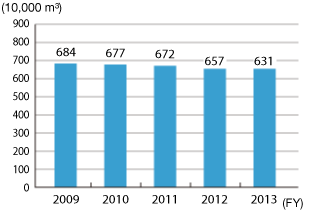
-
Changes in Loading Amount of BOD and COD Per a Year
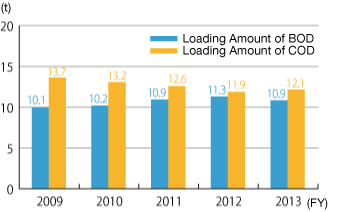
Enforcing Air Pollution Prevention Control
We are trying to enforce our management system by setting up our voluntary set parameter values in order to comply with various regulated values.
There were no incidents that led to air pollution during FY 2013.
Discharging Volume of NOx and SOx, plus Production Quantity per Base Unit
We carefully manage the concentration of our NOx and SOx emissions to fully comply with parameters set by the law, and there was no case where we exceeded our voluntary set parameter value. In FY 2013, we were able to reduce our NOx and SOx emissions compared to FY2012. In particular, we significantly reduced our SOx emissions from FY2012 through combustion conversion. The discharging volume per base unit for both SOx and NOx has decreased. In order to reduce NOx and SOx emissions, we are switching to highly efficient boilers and cleaner fuel.
-
Loading Amount of NOx Emission and its Unit Base
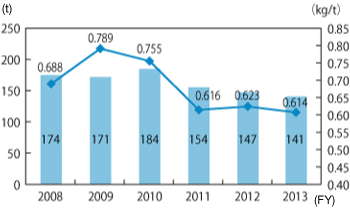
-
Loading Amount of SOx Emission and its Unit Base
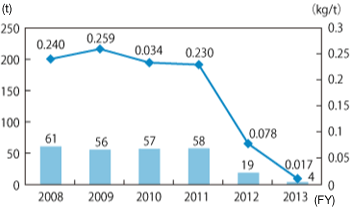
Controlling Emissions of Ozone-Depleting Substances
We used to deploy as a metal cleanser chlorofluorocarbon-141b (HCFC-141b), which is controlled under Montreal Protocol as ozone-depleting substance; as such we had completely abolished using it effective from September 2007 by making some improvements with our cleansing methods. Since then, we no longer use or emit any ozone-depleting substances anymore.
Our Measurements on Contaminated Soil
We are regularly conducting water quality inspections by installing a shallow well for observation purposes in seven of our domestic operation sites (for our Nagano Plant, we are conducting direct soil analysis as they are located high in the water vein, whereas for our Onomichi Plant, we are conducting the analysis of leachate as they are located on the land reclaimed from the sea). Also, even though our Hiratsuka Factory had exceeded the standard on chlorine-organic solvents in the past, cleaning has been completed at one of two locations based on the understating of the authorities that the base value has not been exceeded for at least two years. At the remaining location, currently we are still continuing with the cleansing treatment through aeration; we are currently conducting measurements and monitoring on a regular basis to ensure that the density of underground water is below standard for the underground water environment.
Our Measurements for Dioxide
The Mie Plant that had a waste incinerator was suspended in June 2012. There has been no dioxide since this.
Total Amount of VOCs Emission by the Group in Japan and Overseas
During 2013, the total amount of volatile organic solvent (VOC) emission by the Group in Japan and Overseas was reduced 7.8% year on year to 797 tons.
Total Amount of VOCs Emission by the Group in Japan and Overseas
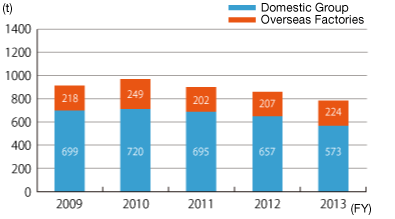
Reduction of VOCs at Domestic Operation Sites
As a result of our effort to reduce volatile organic solvent (VOCs) which is the major substance as to emission amount, we were successfully able to reduce by 11% compared to the previous fiscal year in FY 2013 at our domestic factories. While production volume was nearly the same at the previous year (down by2.5%), this reduction was made possible through initiatives aimed at avoiding toluene and cement in the solvents used during hose manufacturing and the deployment and operation of solvent collection facilities to collect a part of VOCs which we used to emit in the atmosphere in the past. We will continue to promote the reduction of emission amounts going forward.
Total Amount of VOCs Emission and Base Unit of Production Quantity at Domestic Factories
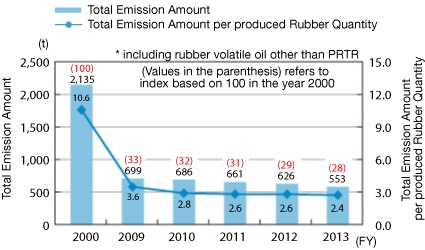
The bars above refer to the total emission amount (emission amount + shifted amount) expressed by the unit [ton].
The line above refers to the emission amount per produced rubber quantity expressed by the unit [kg/ton].
- Calculation formula of unit base = total emission amount / produced rubber quantity
- Including rubber volatile oil other than PRTR (Pollutant Release and Transfer Register)
- Total Emission Amount = Emission Amount + Amount to be Disposed as Industrial Waste (equivalent to shifting portion under PRTR)
Reduction of Chemical Substance under PRTR* at Domestic Factories
In the fiscal year of 2013, the total of emissions and shifting amount of chemical substances under PRTR was 117 tons, which was a reduction by 77.0% compared to the fiscal year of 2000. Especially toluene, which used to be the majority of our emissions to the atmosphere, was reduced by 95.0% compared to the fiscal year of 2000.
Emission Amount of Toluene at Domestic Factories
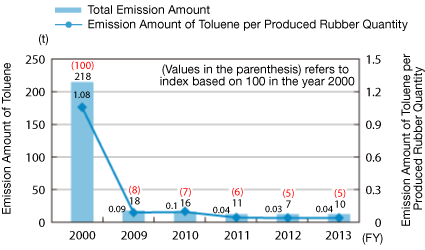
* PRTR refers to a system to register emission and shifting amount of chemical substance. This is a system to understand the source and emission amount of any toxic chemical substances followed by announcing them to the public.